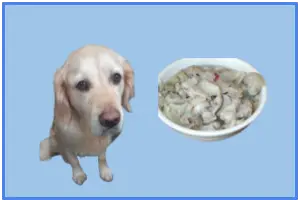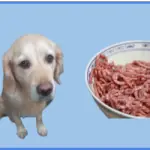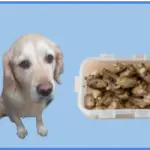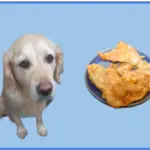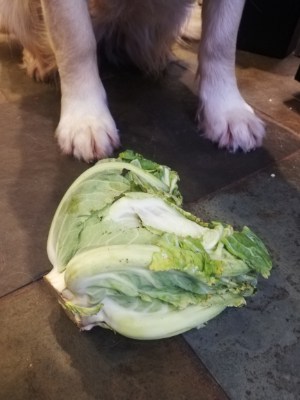
Shocking as it may seem, everyday in America, 150,000 tonnes of food are wasted every single day.
Which is roughly one lb per person.
It is numbers like that get me thinking about waste.
I often feed my dogs cauliflower leaves.
Part of the reason is because I hate waste (and my wife won’t tolerate eating them) but it is also because, as a green leaf, I figure that there must be lots of goodness in them.
But I have no idea about the real details.
So let’s find out shall we?
Can dogs eat cauliflower leaves?
Yes, dogs can eat cauliflower leaves.
Dark green vegetables are known to be incredibly healthy and a rich source of vitamins and minerals.
Obviously cauliflower leaves aren’t dark green but they are green and so they must have some goodness locked in there.
But, what are these vitamins and minerals?
The nutrition in cauliflower leaves
Nowadays, you can get nutritional data on almost all foods.
I use this site.
But cauliflower leaves had me stumped.
Fortunately, some scientists in India have analysed these leaves and so I can use their data.
And I thought that the data makes more sense if I compare the nutrition of cauliflower leaves with the vegetable itself.
After all, most of us have probably tossed a cauliflower floret into our dog’s food bowl at some point or other, haven’t we?
But which provides our dog with the bigger boost?
This data is for a 100g serving
| Cauliflower | Cauliflower Leaves | ||
| Calories | 25 | Calories | 60 |
| Protein | 1.9g | Protein | 5.9g |
| Fat | .3g | Fat | 1.3g |
| Carbohydrate | 5g | Carbohydrate | 7.6g |
| Fibre | 2g | Fibre | 2g |
| Iron | 42mg | Iron | 41 mg |
| Beta Carotene | 0 mg | Beta Carotene | 49.5 mg |
| Water | 92g | Water | 80g |
| Calcium | 22 mg | Calcium | 626 mg |
| Phosphorous | 44 mg | Phosphorous | 107 mg |
A quick look at this comparison chart shows that cauliflower leaves are richer in terms of minerals and vitamins that the vegetable itself.
This is a win/ win situation for you and your dog because you can give them a bigger boost of vitamins and minerals by feeding them the leaves and not the vegetable.
You save on waste and you have more cauliflower to share around the rest of the family.
By rights, we should all be eating the leaves but good luck trying to persuade your nearest and dearest…
When you look at individual nutrients, this isn’t really even a close run race.
The leaves win by a country mile.
Let’s break this down a bit more.
Protein
Cauliflower leaves have triple the amount of protein than cauliflower.
Protein is required in every cell in a dog’s body. It is essential for health and growth.
Carbohydrates
Cauliflower leaves have 150% more carbohydrates than cauliflower itself.
They are the energy and fuel that your dog’s body needs to survive and thrive.
And yes, too many carbohydrates can be a very bad thing but there is zero risk of your dog gorging themselves on carbohydrates by eating vegetables!
Calcium
OK, this is a big one.
The leaves contain thirty times more calcium than the main vegetables.
And why is calcium important? Think strong bones and teeth…
Phosphorous
OK, this mineral needs a bit more explaining, although the leaves are a far richer source for it.
In fact more than double.
Phosphorus is almost a building block in your dog’s body as it helps to maintain strong bones and healthy cells.
There are a few minerals which seem to appear in a cauliflower and its leaves in equal measure.
This is true for fibre and iron.
Raw vs cooked cauliflower leaves
So, now that we know in no uncertain terms that we should be boosting our dog’s diet with cauliflower leaves, should we feed it to our dogs raw or cooked?
I’m not sure that there is a right or wrong answer here.
I think that the most important step is to add them to your dog’s diet and not worry so much about how they are prepared.
After washing the leaves, I tend to just roughly chop them up into 1 cm squares and then mixing a couple of tablespoons in with their food.
The size of the portion should be in relation to the size of your dog and your dog’s familiarity with the leaves.
For instance, if your dog has never had cauliflower leaves before, start them with a small portion.
My dogs are Golden Retrievers and have cauliflower leaves every couple of weeks.
If you are uncomfortable with feeding your dogs raw leaves, then just wash them and chop them into small chunks and steam them for a few minutes.
How many cauliflower leaves should I feed my dog everyday?
When you introduce a new food to a dog, you should always start small and build up slowly.
When it comes to adding something like cauliflower leaves to your dog’s food, I think that you should aim for a maximum of 10% of their daily food intake.
So my dogs are on about 500g of food per day and so the maximum amount of cauliflower leaves that I would add into their bowl would be 50g (or five tablespoons.)
More like a garnish if you will!
Would I feed them cauliflower leaves everyday?
No, I wouldn’t. Although cauliflower leaves are a great nutritional boost, they only provide the same set of vitamins and minerals time and time again.
I would want to vary the vitamins and minerals that my dogs received.
And the way that I do this is to add a variety of vegetables into their diet.
And I will guide you through one of the ways that I do this in my next section.
Other nutritional leaves and stems from vegetables
I have other favourite waste vegetable products that find their way into my dog’s food bowls and one of their favourites are broccoli stems.
On the face of it, it’s madness that more of us don’t eat the stalk ourselves.
Science tells us that the darker a vegetable is, the more nutrition it holds.
And so on this scale a broccoli stalk is a superfood.
The full breakdown can be seen here but for the main headlines, glance to your right.
Broccoli stalks are a great source of vitamin C, vitamin B6, manganese and a little known acid called pantothenic acid,
My dogs like to eat it in quite big chunks.
They “go mad” for both the flavour and the texture.
Sweet potato peelings
Another regular visitor to my dog’s bowls are sweet potato peelings.
If it was left up to me, I would cook our sweet potatoes with their skins on.
But, my wife likes hers peeled and so my loss is my dogs’ gain!
Call me a cheapskate if you will but vegetable skins tend to hold huge amounts of nutrients.
And sweet potato skins are an important source of fibre and antioxidants.
Closing Thoughts
By reading this article you will have realised that cauliflower leaves make an excellent addition to your dog’s food.
Quite surprisingly, the leaves offer as much nutrition or even more than cauliflower itself.
For me they seem to be a rich source of calcium, iron and phosphorus in particular.
What I also hope to have achieved is to show you that many of the parts of vegetables that we throw away or compost are very nutrient rich and that there is no reason why they shouldn’t be given to your dog either.

